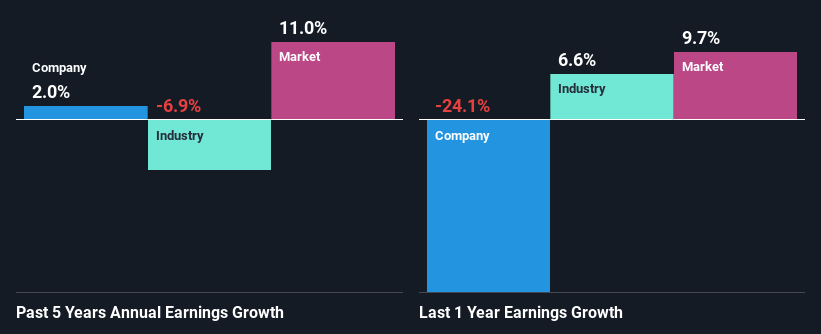Coca-Cola HBC AG's (LON:CCH) Stock Has Fared Decently: Is the Market Following Strong Financials?
Most readers would already know that Coca-Cola HBC's (LON:CCH) stock increased by 9.7% over the past three months. Given that the market rewards strong financials in the long-term, we wonder if that is the case in this instance. In this article, we decided to focus on Coca-Cola HBC's ROE.
ROE or return on equity is a useful tool to assess how effectively a company can generate returns on the investment it received from its shareholders. Put another way, it reveals the company's success at turning shareholder investments into profits.
See our latest analysis for Coca-Cola HBC
How Is ROE Calculated?
The formula for ROE is:
Return on Equity = Net Profit (from continuing operations) ÷ Shareholders' Equity
So, based on the above formula, the ROE for Coca-Cola HBC is:
12% = €416m ÷ €3.4b (Based on the trailing twelve months to December 2022).
The 'return' is the amount earned after tax over the last twelve months. So, this means that for every £1 of its shareholder's investments, the company generates a profit of £0.12.
What Is The Relationship Between ROE And Earnings Growth?
So far, we've learned that ROE is a measure of a company's profitability. Depending on how much of these profits the company reinvests or "retains", and how effectively it does so, we are then able to assess a company’s earnings growth potential. Assuming everything else remains unchanged, the higher the ROE and profit retention, the higher the growth rate of a company compared to companies that don't necessarily bear these characteristics.
Coca-Cola HBC's Earnings Growth And 12% ROE
To start with, Coca-Cola HBC's ROE looks acceptable. And on comparing with the industry, we found that the the average industry ROE is similar at 11%. Despite the moderate return on equity, Coca-Cola HBC has posted a net income growth of 2.0% over the past five years. So, there could be some other factors at play that could be impacting the company's growth. For instance, the company pays out a huge portion of its earnings as dividends, or is faced with competitive pressures.
Next, on comparing with the industry net income growth, we found that the growth figure reported by Coca-Cola HBC compares quite favourably to the industry average, which shows a decline of 6.9% in the same period.
Earnings growth is an important metric to consider when valuing a stock. What investors need to determine next is if the expected earnings growth, or the lack of it, is already built into the share price. Doing so will help them establish if the stock's future looks promising or ominous. What is CCH worth today? The intrinsic value infographic in our free research report helps visualize whether CCH is currently mispriced by the market.
Is Coca-Cola HBC Using Its Retained Earnings Effectively?
The high three-year median payout ratio of 51% (that is, the company retains only 49% of its income) over the past three years for Coca-Cola HBC suggests that the company's earnings growth was lower as a result of paying out a majority of its earnings.
Moreover, Coca-Cola HBC has been paying dividends for at least ten years or more suggesting that management must have perceived that the shareholders prefer dividends over earnings growth. Our latest analyst data shows that the future payout ratio of the company over the next three years is expected to be approximately 46%. Regardless, the future ROE for Coca-Cola HBC is predicted to rise to 19% despite there being not much change expected in its payout ratio.
Summary
Overall, we are quite pleased with Coca-Cola HBC's performance. We are particularly impressed by the considerable earnings growth posted by the company, which was likely backed by its high ROE. While the company is paying out most of its earnings as dividends, it has been able to grow its earnings in spite of it, so that's probably a good sign. That being so, the latest analyst forecasts show that the company will continue to see an expansion in its earnings. To know more about the latest analysts predictions for the company, check out this visualization of analyst forecasts for the company.
Have feedback on this article? Concerned about the content? Get in touch with us directly. Alternatively, email editorial-team (at) simplywallst.com.
This article by Simply Wall St is general in nature. We provide commentary based on historical data and analyst forecasts only using an unbiased methodology and our articles are not intended to be financial advice. It does not constitute a recommendation to buy or sell any stock, and does not take account of your objectives, or your financial situation. We aim to bring you long-term focused analysis driven by fundamental data. Note that our analysis may not factor in the latest price-sensitive company announcements or qualitative material. Simply Wall St has no position in any stocks mentioned.
Join A Paid User Research Session
You’ll receive a US$30 Amazon Gift card for 1 hour of your time while helping us build better investing tools for the individual investors like yourself. Sign up here

 Yahoo Finance
Yahoo Finance 
